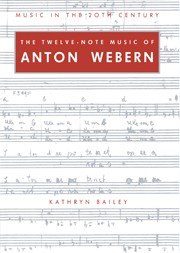Book contents
- Frontmatter
- Contents
- Acknowledgements
- Conventions in the text
- Introduction
- PART I Row and canon
- PART II The instrumental music
- PART III The music with voices
- Conclusion
- Appendices
- I A comparison of row characteristics
- II Matrices
- III Row analyses (1)
- IV Row analyses (2)
- V A note on Webern's graces
- Notes
- Glossary
- Chronological worklist
- Select bibliography
- Index
V - A note on Webern's graces
Published online by Cambridge University Press: 23 December 2009
- Frontmatter
- Contents
- Acknowledgements
- Conventions in the text
- Introduction
- PART I Row and canon
- PART II The instrumental music
- PART III The music with voices
- Conclusion
- Appendices
- I A comparison of row characteristics
- II Matrices
- III Row analyses (1)
- IV Row analyses (2)
- V A note on Webern's graces
- Notes
- Glossary
- Chronological worklist
- Select bibliography
- Index
Summary
Grace notes are one of the characteristic features of Webern's music, appearing in all the twelve–note works up to Op. 27 – in some cases, notably Opp. 20, 22, 23 and 26, in quite astonishing profusion. The directional nature of the grace note (it can only precede, never follow) and its tendency to blur rhythmic outlines meant that it was not congenial to the increased concentration on rhythmic motives and their permutations in the works directly following Op. 26. Thus there are only a few in the second and third movements of Op. 27 and none in Opp. 28, 29 and 30. The grace makes a reappearance, however, in conjunction with Webern's ‘completely new style of presentation’ in the Op. 31 Cantata (movements II, III and V). In all these works, the notation is the same: a small quaver with a slash through the stem connected to the following note by a slur.
In the vast majority of cases, the grace and the note following it occupy successive positions in a row. Most often they occur alone: that is to say, no other pitches from the same row are sounded at the same time. This is the result either of a linear presentation of the row or of the isolation of the pair of notes within a non–linear statement. It is frequently the case that a linear statement of the row is only one of several strands progressing together: although there are other pitches sounding, perhaps even struck at the same time as the ones in question, the grace note and its successor are nevertheless isolated with respect to their own row.
- Type
- Chapter
- Information
- The Twelve-Note Music of Anton WebernOld Forms in a New Language, pp. 410 - 415Publisher: Cambridge University PressPrint publication year: 1991

